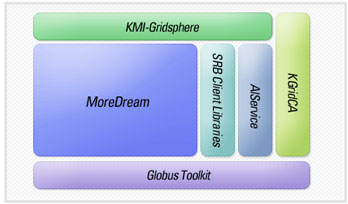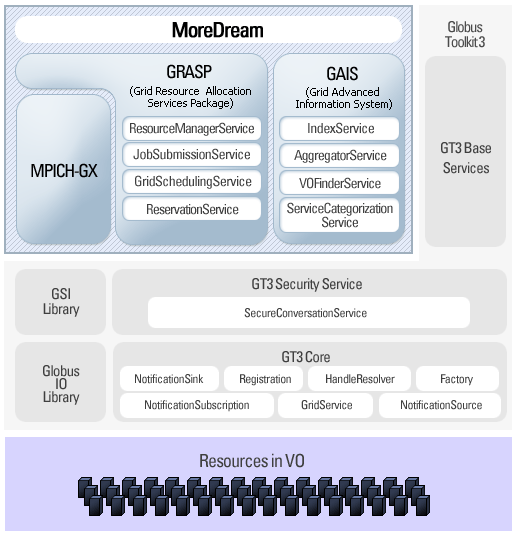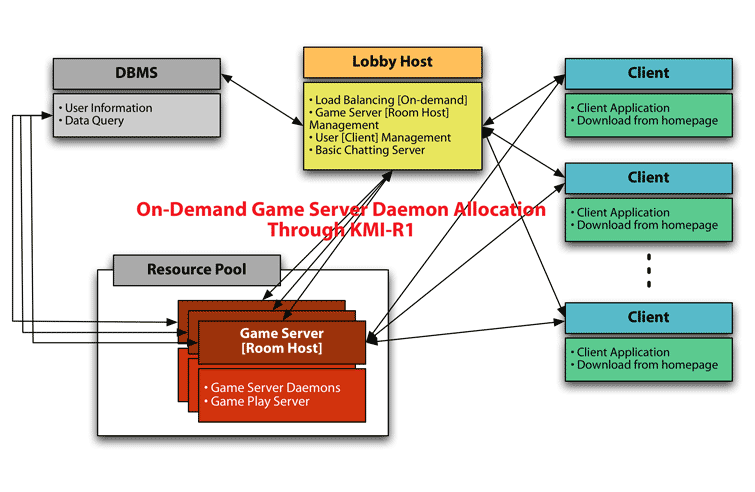
February 2006
|
Construction and Utilization of the Cyberinfrastructure in Korea
|
 February 2006 |
The number of subscribers for high-speed internet service in Korea reached more than twelve million at the end of 2005. This was the result of a national project, VSIN (Very high Speed Information Network), which was launched in 1995 by MIC (Ministry of Information and Communication) of Korea. The most notable result was the completion of a nation-wide optical communication cable infrastructure. It has provided high-speed communication networks to most commercial buildings and apartments in Korea. The Korean government then built internet services upon the infrastructure, which enabled e-government services, e-commerce services, and other IT application services with low cost and high quality.
The governmental budget for science and technology research and development reached 7 trillion won (about $7 billion US) in 2005. After the success of VSIN, the Korean government has tried to enhance the competitiveness of science and technology, such as bio-technology and nano-technology, by introducing VSIN and advanced IT technologies, such as the Grid, to the research processes of science and technology, which lags relatively behind developed countries. As a part of the plan, an initiative for the comprehensive implementation of Korean national Grid infrastructure (K*Grid) was started in 2002 by MIC.
KISTI (Korea Institute of Science and Technology Information) plays a leading role in construction and operation of the production quality Grid infrastructure needed for large-scale collaborative research in scientific and commercial applications. The main goal of the K*Grid infrastructure, which integrates huge amounts of computing power, massive storage systems, and experimental facilities as a virtual single system, is to provide an extremely powerful research environment for both industries and academia. The K*Grid project includes construction of the K*Grid infrastructure including Access Grid, development of its middleware, and research and development of Grid applications.
In this article, the current status and activities about the construction and utilization of the cyberinfrastructure in Korea is described.
The construction of the K*Grid infrastructure is divided into two phases: the first phase (2002-2004) was for constructing Grid testbeds and providing basic Grid services with 15 small-scale cluster systems from computing centers and university laboratories. As the interests in Grid have increased, the demand for a sustainable, production level Grid infrastructure has been rapidly growing not only from users from the K*Grid project, but also from related projects such as, e-Science project of Korea and KoCED (KOrea Construction Engineering Development) project.
The second phase (2005-2006) of the K*Grid infrastructure is the result of such requirements. Its objective is to construct a reliable Grid service infrastructure for TFLOPS level. At present, three organizations, SNU (Seoul National University), PNU (Pusan National University) and KISTI, are involved. They are making invaluable contributions for sharing high-performance computing resources using the scientific research network of KREONET (Korea Research Environment Open NETwork).
The K*Grid portal, a web-based Grid service platform for providing an easy-to-use environment to the user, has been developed based on Java and web service technology. It provides a job management and execution environment, and various application modules will be integrated later based on requirements from application researchers. The K*Grid infrastructure is expected to be used in diverse fields, far beyond traditional applications of supercomputing. It is expected to play a pivotal role in R&D in Korea as the research and development cyberinfrastructure of Korea.
AG activity in Korea started in 2002 as a part of the K*Grid project. The AG infrastructure of Korea started as a one room type node at KISTI and developed into a six room type with over fifty PIG (Personal Interface to the Access Grid) nodes that are actively used in such areas as e-Science, bioinformatics, medicine, meteorology. The long term goal of AG activities in Korea is to provide enhanced AG systems as the next generation high-end collaborative infrastructure for researchers in Korea.
In order to facilitate a domestic AG community, KISTI develops various additional AG servers, provides enhanced services and technical support, and holds annual workshop and tutorials. KISTI also has been conducting research to enhance the performance of the AG infrastructure, such as a high quality media stream transmission and a high adaptive network compatibility tool for AG connector, which provides easy access from several types of networks such as NAT, VPN, and through firewalls. MEET (Multicast Debugging Toolkit with End-to-End Packet Trace), a near real-time multicast accessibility and quality monitoring framework with a web-based graphical user interface, is also being developed. MEET is able to (1) carry out proactive multicast diagnosis, and (2) provide easy accessibility for multicast users via the toolkit. In addition, an HDTV media steam transmission over AG technique has been developed and deployed, and international joint research with ANL toward building the next AGTk (Access Grid Toolkit) with an AGPM (Access Grid Package Manager) technique is in progress.
AG is being used in increasingly diverse situations, such as remote medical examination and treatment, bioinformatics, and education. In particular, usage in the medical area is very significant –– it is currently used in remote lecture, remote presentation, remote workshop, and it is expected that usage in remote surgery as well as remote collaborative medical examination and treatment will be popular in the near future. KISTI’s AG has also been used to help international collaboration in such areas as Grid, supercomputing application research, medicine and bioinformatics.
K*Grid middleware has been developed as a part of the K*Grid project. KMI-R1 (K*Grid Middleware Initiative - Release 1) is an integrated Grid middleware package that helps scientists to easily setup computational and data Grid environments for their research as well as harness all the advantages of Grid at their fingertips. KMI was originally developed for the K*Grid infrastructure (see Figure 1) but is not limited to it. KMI-R1 is an integration of the MoreDream Toolkit (developed by KISTI) with some key software packages such as Globus Toolkit (developed by ANL), KGridCA system (developed by KISTI) for the Grid certificate authority service, AIService (developed by KISTI) for the Grid accounting service, SRB (Storage Resource Broker, developed by SDSC), and KMI-GridSphere (optimized with GridSphere developed by GridLab).

MoreDream is a Grid middleware toolkit which allows scientists in many application areas to easily use the Grid environment and to utilize necessary resources, such as computing resources, data, storage, and experts geographically and organizationally distributed. In the MoreDream project, three research issues beneficial to scientists are the foci. The major components of MoreDream (Figure 2) are GRASP (Grid Resource Allocation Services Package) for Grid resource allocation service, GAIS (Grid Advanced Information System) for Grid information service, and MPICH-GX for parallel computing service. Each component has extended functionalities of the Globus Toolkit 3 (GT3). The services of MoreDream are implemented based on the OGSI (Open Grid Service Infrastructure) of GT3.

Currently, managed job service in GT3 is to be used to run a job on a remote resource. However, in order to build a more useful Grid, there should be additional user-friendly resource allocation, including resource brokering, scheduling, monitoring, and so forth. To meet this requirement in the Grid resource management area, we designed and implemented a resource allocation system named GRASP, which is to allow users to submit their jobs in a more efficient and intelligent manner. The services of GRASP were implemented based on the OGSI. GAIS is an OGSI-compliant information system that extends GT3 MDS3 and conforms to a flat and dynamic architecture. It provides more plentiful resource information and advanced functionalities in order to satisfy the requirements for various Grid applications in the K*Grid. MPICH-GX is an enhancement of MPICH-G2, extending functionalities required in the Grid. MPICH-G2 is a well-defined implementation of Grid-enabled MPI, but it need to be modified for supporting some requirements of Grid applications. The detailed information about all the components of KMI-R1 can be found at http://kmi.moredream.org/.
Research on Grid application has been conducted as a part of the K*Grid Project. Its primary goal is to develop Grid-based applications to improve the quality of service via Grid technology and to gather requirements from various applications for further research. Scientific application had been the major focus until 2004, and now its focus has shifted to IT applications such as on-line game service, telematics navigation service and rendering service.
Firstly we developed a high quality telematics navigation service based on Grid Technology. It serves realistic 3D image content in the Grid environment. The Grid-based telematics navigation service is composed of four elements: Grid-based load-balancer, navigation client, 3D image provider and load monitoring agent.
The objective is to develop a high quality online game service on the Grid environment and allocate a real-time game server according to the number of concurrent game users. We developed an online game server from a Grid pool constructed by MoreDream middleware that manages game daemons. It is composed of four elements: lobby host, room host, data center and monitoring tool (Figure 3).

The objective of Grid based rendering service is to accomplish a commercial or non-commercial rendering project on the Grid environment. Locally distributed render farms (Daejeon, Seoul) are interoperated by RenMan™ , which manages and accomplishes rendering services based on the Grid. Table 1 below shows what has been accomplished in the system.
| Manufacturer | Renderer | Production | Contents | Execution Time (hour) | Remark |
|---|---|---|---|---|---|
| DOES | 3D-MAX 7.0 | Anycall CF in "AnyParty" of Anycall CF in Samsung | TV, theater in HD format | 8 | Simple distributed processing |
| HUG | MAYA 6.5 | PR image for National Health Insurance Corporation | Large number of jobs | 25 | Ray Tracing |
| AURUM | MAYA 7.0 | Model House Simulation for Daewoo Apartment | Extremely realistic expression | 8 | Simple distributed processing |
| SEMOLogic | MAYA 7.0 | "God of War II" intro movie for Play Station II in Sony Computer Entertainment(US) | 3.2GB Input data | 1 frame is divided to 12 layers | 6/ Frame |
The main focus of the K*Grid project is for the construction of next generation internet and business applications, and little attention is given to scientific applications. In order to complement the situation, the Korea e-Science project started by MOST (Ministry of Science and Technology) of Korea with the intention of providing advanced collaborative environments to researchers distributed over the country.
Currently, advanced environments, or problem solving environments, are being constructed in five application areas (Table 2) as a part of the Korea e-Science Project. Each application will be developed using common application support software and infrastructures that was built by the K*Grid. Although it will take three years to complete the environments, test service of the environments will start by the beginning of 2006.
| Title | Organization | Area |
|---|---|---|
| Development of molecular simulation e-Science research environment and e-Glycoconjugates | Konkuk University | BT, NT |
| Development of e-Science Environment for HG2C based on service oriented architecture | Soongsil University | BT |
| Construction of numerical wind tunnel on the e-Science infrastructure | Seoul National University | Aerospace |
| Establishment of e-Science environment using the high voltage electron microscope | KBSI | Equipment control |
| Construction of e-Science environment for weather information system | Pukyoung University | Meterology |
As part of the Korea e-Science Project, workflow, visualization, and user portals are the main software areas of focus. These are intended to be made as general as possible, so they can be used in other applications projects (Table 1) and among other related communities. Extracting common components from various areas of applications is not expected to be an easy task. We start from a specific field of aerospace, discuss with area application developers to extract commonly used components, and define common application support software. Naturally, it will be extended to other application areas to define and refine common application support software.